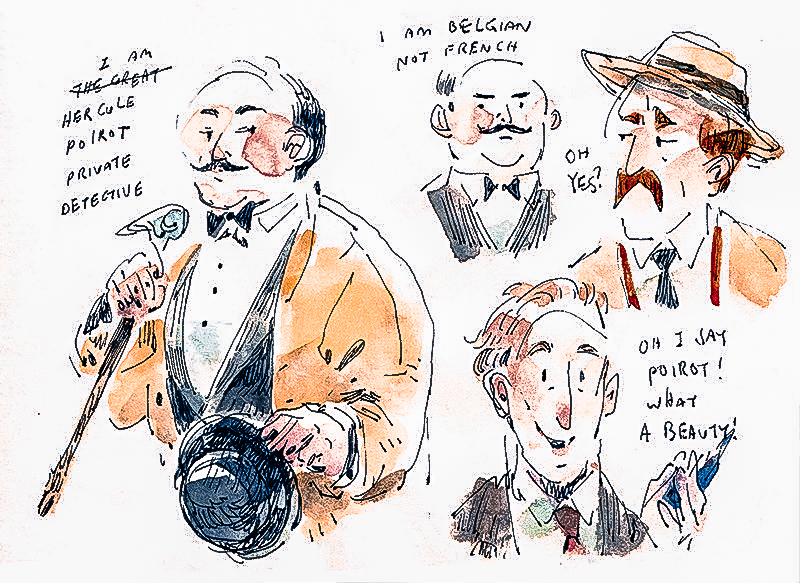In celebration of Agatha Christie’s birthday and this month’s BCCC theme (and my entry for the BCCC Bingo), I’ll be going through my top 5 novels featuring one of my favorite detectives of all time – Hercule Poirot.
Who is Hercule Poirot?
Hercule Poirot is one of Agatha Christie’s most famous detectives. The Belgian detective was introduced to the world in 1920 and has since appeared in 33 novels, 51 short stories, and 2 plays.
In appearance, he is neat, fastidious, and sports a fantastic moustache. He also has green eyes that shine like a cat’s when he’s on to something.
He was hardly more than five feet four inches but carried himself with great dignity. His head was exactly the shape of an egg, and he always perched it a little on one side. His moustache was very stiff and military. Even if everything on his face was covered, the tips of moustache and the pink-tipped nose would be visible. The neatness of his attire was almost incredible; I believe a speck of dust would have caused him more pain than a bullet wound. Yet this quaint dandified little man who, I was sorry to see, now limped badly, had been in his time one of the most celebrated members of the Belgian police.
Captain Hastings, The Mysterious Affair at Styles
He boasts about employing his “little grey cells” to solve any problem and points to “order and method” as key to his success. “A mere matter of method” is how Poirot describes detective work to Captain Hastings.
Top 5 Novels Featuring Poirot
Poirot featured in 33 novels of Christie. Suffice it to say, even though she’d no love for his character in particular (like Ariadne Oliver with her particular Finn detective), she recognized his popularity with the audience.
In no particular order (anathema to the great detective ironically), here are my most-liked Poirot novels:

#1 The Mysterious Affair at Styles
The story begins when Hastings is sent back to England from the First World War due to injury and is invited to spend his sick leave at the beautiful Styles Court by his old friend John Cavendish. Here, Hastings meets John’s step-mother, Mrs. Inglethorp, and her new husband, Alfred. Despite the tranquil surroundings Hastings begins to realize that all is not right. When Mrs. Inglethorp is found poisoned, suspicion falls on the family, and another old friend, Hercule Poirot, is invited to investigate.
Why I liked it
Apart from being the first book featuring Poirot, it also showed life in England during the war. It was interesting to read what the people did during that time, speaking as someone who is fortunate enough not to have gone through any war or armed conflict. Rations of goods, volunteering with the local charities and hospitals, running bazaars for the war effort – it’s a fascinating glimpse of history written by people who’ve lived through it, and meshed into a fictional, detective story.
#2 Mrs. McGinty’s Dead
‘Mrs. McGinty’s dead!’ ‘How did she die?’ ‘Down on one knee, just like I!’ The old children’s game now seemed rather tasteless. The real Mrs. McGinty was killed by a crushing blow to the back of the head and her pitifully small savings were stolen. Suspicion falls immediately on her lodger, hard up and out of a job. Hercule Poirot has other ideas – unaware that his own life is now in great danger.
Why I liked it
Poirot’s comments on the domestic arrangements were relatable and funny as heck. In this story, he got called in by an old friend (this was later in Poirot’s career) who was convinced that the man convicted of murder was innocent.
Poirot goes to stay in Mrs. Summerhayes’ boarding house to be closer to the action. The house was dilapidated, there was dust everywhere, and a (suspected) mangy dog took up position on the relatively comfortable chair.
I suffer…Yes, I suffer.
Hercule Poirot, Chapter 4
In the end, though, the real bad guy is arrested and Poirot was able to teach omelet making to his hostess (there’s a callback to this in a later novel). So all’s well that ends well.


#3 The ABC Murders
There’s a serial killer on the loose, working his way through the alphabet – and the whole country is in a state of panic. A is for Mrs. Ascher in Andover, B is for Betty Barnard in Bexhill, C is for Sir Carmichael Clarke in Churston. With each murder, the killer is getting more confident – but leaving a trail of deliberate clues to taunt the proud Hercule Poirot might just prove to be the first, and fatal mistake.
Why I liked it
This is the first (and only?) Christie book that I read where it featured a serial killer. And his calling card is an ABC guide left at the murder scenes. Do you know what an ABC guide is? I didn’t. It’s a railway guide apparently, listing all the railway stations in alphabetical order, hence the term “ABC”.
It’s a creative concept (in the context of murder mysteries and not in real life) – each victim is killed in alphabetical order and in locations that correspond to a page marked in the ABC guide. The killer possesses a lot of imagination, is cocky enough to preempt his murders with taunting letters to Poirot and planned his murders well in advance but he’s still no match for Poirot!
#4 Cards on the Table
Mr. Shaitana was famous as a flamboyant party host. Nevertheless, he was a man of whom everybody was a little afraid. So, when he boasted to Poirot that he considered murder an art form, the detective had some reservations about accepting a party invitation to view Shaitana’s private collection. Indeed, what began as an absorbing evening of bridge was to turn into a more dangerous game altogether.
Why I liked it
This was another of Christie’s books that I liked because of its imaginative plot – 4 detectives, 4 criminals, and 1 “collector”.
A party of eight and himself. Four “sleuths”, so to speak – and four murderers!
Superintendent Battle, Chapter 4, First Murderer
Each sleuth is a representative of their peculiar subset of detective – the Police, the Secret Service, the Private Detective, the Fictional Detective – and they each back their own “horses”. The accused are no less interesting – medical malpractice, poison, domestic accident, shooting accident – Mr. Shaitana certainly baited someone to his fatal detriment. Each of the criminals had opportunity and motive for murder. At the end of the day, when all the cards are laid on the table, Poirot has the winning hand.

#5 Sad Cypress
Last, but certainly not the least, is Sad Cypress. The title itself is intriguing and melancholic, which is perfect for the tone of this book.

An elderly stroke victim dies without having arranged a will. Beautiful young Elinor Carlisle stood serenely in the dock, accused of the murder of Mary Gerrard, her rival in love. The evidence was damning: only Elinor had the motive, the opportunity and the means to administer the fatal poison. Yet, inside the hostile courtroom, only one man still presumed Elinor was innocent until proven guilty: Hercule Poirot was all that stood between Elinor and the gallows.
Why I liked it
Poirot finds clues in the rose bushes and that endeared this book to me. Seriously speaking, of course that’s not all the reasons why I liked this book.
What struck me the most with this story is that it wasn’t the usual, casual, light (if you can call a murder story light) Poirot story. Even though the murderer’s motivation was greed, a prosaic reason, there were elements of romance and nostalgia in the story, more than the other Poirot stories. There was a mention of childhood memories of playing together, and the headiness and unreasonableness of first love.
This other thing is like an enchantment! It’s upset everything: my conception of life – and my enjoyment of things – and – all the decent, ordered, reasonable things.
Elinor said gently, “Love – isn’t very reasonable.”
Chapter 4
There are several examples of unrequited love, longing, and what-ifs that lend the story an atmosphere of suspense, melancholy, hopelessness – something intangible at least. The dialogues are well crafted and touch on human nature. I’m explaining it very badly so I guess I’ll just add a few quotes that will hopefully explain what I mean and show you why I absolutely love this book.
Elinor said, “When we were children. It’s a pity, Mary, isn’t it, that one can never go back?”
Mary said, “Would you like to go back?”
Elinor said with force, “Yes – yes.”
Chapter 7
Hercule Poirot’s voice was very gentle as he said, “Can you not accept facts? She loved Roderick Welman. What of it? With you, she can be happy.“
Chapter 26
So that’s my roundup of Poirot stories that I absolutely enjoyed. I’m grateful that Agatha Christie introduced this fantastic detective to the world and his popularity goes on and on. Have you watched the last Poirot movie? Which book is your favorite?


